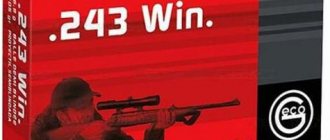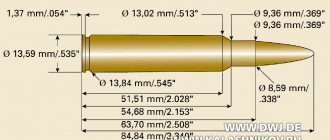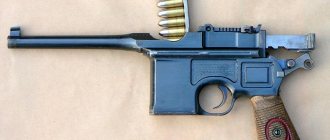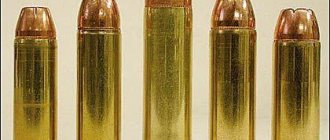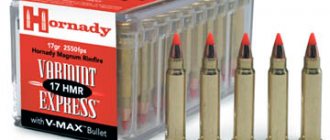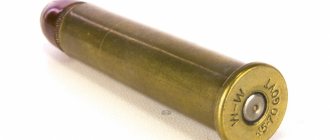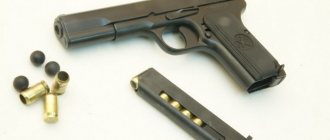| .270 Winchester | ||||||||||||||||||||
| Four .270 Winchester cartridges with different types of bullets. | ||||||||||||||||||||
| Type | Gun | |||||||||||||||||||
| Country of origin | US | |||||||||||||||||||
| production history | ||||||||||||||||||||
| developed | 1923 | |||||||||||||||||||
| Creator | Winchester Repeating Arms Company | |||||||||||||||||||
| Production | 1925 - present | |||||||||||||||||||
| Characteristics | ||||||||||||||||||||
| Based | .30-03 Springfield | |||||||||||||||||||
| shell type | Bottle without flange, center blow | |||||||||||||||||||
| Caliber | 7 mm (0.276 pg) | |||||||||||||||||||
| neck diameter | 7.8 mm (0.307 pg) | |||||||||||||||||||
| base diameter | 11.9 mm (0.469 pg) | |||||||||||||||||||
| rim diameter | 12 mm (0.472 pg) | |||||||||||||||||||
| rim thickness | 1.1 mm (0.043 pg) | |||||||||||||||||||
| shell length | 64.5 mm (2539 pg) | |||||||||||||||||||
| total length | 84.8 mm (3339 pg) | |||||||||||||||||||
| ballistic characteristics | ||||||||||||||||||||
| ||||||||||||||||||||
| Source: Hodgdon, [1] Hornady [2] | ||||||||||||||||||||
| [edit data in Wikidata] | ||||||||||||||||||||
.270 Winchester cartridge
was developed by the Winchester Repeating Arms Company in 1923 and debuted in 1925 as a cartridge for their Winchester Model 54 bolt-action rifle. [3] The cartridge was designed specifically for hunting and is based on the .30-03 Springfield case, [4] suitable for a 0.277 in (6.8 mm) caliber bullet that expands or fragments rapidly in tissue, this cartridge provides amazing terminal performance. [ 5 ] [ ][ 7 ]
Cartridge
In 1925, Winchester released . 270 Winchester
, then called the .270 WCF, which was likely developed from the 30-03 Springfield case, the neck of which was adjusted to accommodate a 0.277 in (6.8 mm) caliber projectile.
The .270 Winchester took several years to reach the popularity it enjoys today due to the recent popularity of the 30-06 Springfield due to the availability of bolt action Springfield rifles available in the US and also due to that the lever, the design of the .270 Win that was not suitable for carbines of that time, and the lack of promotion in publications of that time. However, this cartridge has become one of the most popular cartridges among sport hunters around the world due to the flat trajectory and high muzzle velocity it produces when used with the .130 grain Spitzer projectile.
Besides the .270 Winchester, the only other .277 cartridge popular with hunters was the .270 Weatherby Magnum, which, while faster and produces a flatter trajectory, is also a more expensive, less available, and more expensive cartridge. the barrels wore out quickly, characteristics that prevented it from achieving the popularity of the .270 Winchester. In 2002, Winchester released the .270 Winchester Short Magnum as part of its line of Short Magnum cartridges, which are marketed as known to produce higher velocities from the cartridge. which can be fed by a short action action similar to the .308 Winchester..270 WSM outperformed the .270 Winchester by firing the same weight projectile 200 feet per second faster, which logically increased the range of the projectile before it began to fall.
The .270 Winchester cartridge became very popular thanks to positive reviews from writer Jack O'Connor, who used and promoted the cartridge for forty years, highlighting its merits in the pages of Outdoor Life
[8][] for its flat trajectory and high muzzle velocity, which allow long-range shots to be fired with enough energy to bring down medium-sized prey such as white-tailed deer, mule deer or goats, lambs, chamois and mountain goats, efficient and ethical, as well as the ability to chamber cartridges in relatively lightweight rifles and produce manageable recoil for most hunters, making it suitable for hunting in open country and mountainous areas.
Initially, commercial cartridges were loaded to propel an 8.4 g (130 grain) bullet at about 960 m/s (3,140 ft/s) from the muzzle of a twenty-four-inch gun. Later the muzzle velocity was reduced to 930 m/s (3060 ft/s) when fired from a 24-inch gun. However, the use of 22-inch barrels became more popular, resulting in muzzle velocity reductions of 50–100 fps. During its introduction, the cartridge showed strong performance, being advertised as suitable for hunting large game at ranges from 270 to 460 m (270 to 460 m). 300 to 500 yards). Two additional bullet weights were soon introduced: the 6.5 g (100 grain) hollow point for vermin hunting and the 9.7 g (150 grain) which have a higher sectional density making them more suitable for deer hunting. large ones such as wapiti, red deer, and elk, [3] which are projectile weights that can be stabilized in 1:10-inch shotguns.
Although it was not an immediate success, in the following decades and especially in the post-World War II period, the .270 Winchester gained great popularity among gun owners and hunters due to the rise in popularity of the use of optical sights that allow you to take advantage of its benefits, becoming one of the most popular and widely used hunting cartridges in the world. Internationally, gun manufacturers now offer all varieties of rifles to fire this cartridge: bolt-action, single-shot, lever-action, semi-automatic and many others, and even a few double-action rifles.[10]
Cartridge .270 Winchester / 7×64
| .270 Winchester |
The .270 Winchester cartridge in 7x64 mm caliber has the following designations: .270 Winchester / .270 Win / .270 WCF / .270 Winchester Center Fire / .270 Winchester CF / 7x64 / DWM638 / SAA 3345 / XCR 07 064 BGC 030. .270
Winchester
The .270 Winchester cartridge was developed by Winchester in 1925 for its own Winchester rifle mod. 54 with a rotating bolt of the same year of manufacture.
The new ammunition immediately became very popular. Moreover, its popularity was facilitated by the famous writer and hunter OConnor, who called the .270 the best cartridge.
The .270 Winchester cartridge was created by compressing the neck of a .30-06 Springfield case to 7mm for a 7mm bullet. In this regard, a weapon designed to fire .30-06 Springfield cartridges can be quite simply converted to use the .270 Winchester cartridge by replacing the barrel; the rest of the mechanism requires virtually no changes.
The .270 Winchester has a very flat trajectory and high shooting accuracy, in which it is slightly inferior to the .243 Winchester cartridge, however, the range of bullets is diverse (semi-jacketed Teilmantel-R, Nosier Partition and PRO-Amm and expansive Silvertip, Ballistic Tip, H-Mantel) and weight (8.4-9.7 g) is much more modest, but also quite large.
In terms of bullet energy at a distance of 200 m from the muzzle, the .270 Winchester is almost as good as the .308 Winchester cartridge, providing better trajectory flatness and excellent long-range shooting accuracy.
Powder charge - 2.96-3.95 g, muzzle velocity and energy, respectively, 800-930 m/s and 3104-3656 J. Effective firing range - up to 300 meters or more.
Due to its extraordinary accuracy and flat trajectory, the commercial .270 caliber cartridge has been adopted by sniper weapon manufacturers, and most manufacturers manufacture weapons chambered for this cartridge.
The .270 Winchester cartridge is distributed mainly in the USA, although it is widely produced in Europe (Hirtenberger, Norma, RWS, Sellier & Bellot) and in Africa (РМР).
Combining high power with moderate recoil, this cartridge is a hit with shooters of all ages and skill levels.
The .270 Winchester cartridge has the following technical characteristics: beltless bottle-shaped case, Large Rifle type capsule, maximum bullet diameter 7.06 mm, case and cartridge lengths 64.52 mm and 84.84 mm, respectively, barrel rifling pitch 10 inches, powder pressure gases 3700 bar. Case trimming - up to 64.262 mm. The capacity of the sleeve is 4.367 g of water.
When shooting at the optimal zeroing distance of a Winchester .270 cartridge with a Silvertip bullet weighing 8.4-9.7 g, the bullet deviates from the aiming line no more: at a distance of 50 m - +1.0 cm, 100 m - +4.0 cm , 150 m – +3.5 cm, 200 m – -12.0 cm, 300 m – -24.0 cm.
| .270 Winchester |
Bullets and propellant charges
Typically available projectiles that can be stabilized with 1:10 pitch guns range from 6.5 to 10.4 g (100 to 160 grains), with 8.4 g and 9.7 g (130 grains) being the most popular and 150 grains). Shooters who reload their cartridges have more options as bullet weights are available, from 5.8 g to 11.7 g (90 to 180 grains). The bullet weights usually recommended for hunting various game are as follows:
- 5.8–7.1 g (90–110 grain) bullets: From animals smaller than coyote to small deer.
- 8.4 g (130 grain) bullets - antelope, goats and other animals up to the size of a mule deer.
- 9.1–10.4 g (140–160 grain) bullets: deer, elk, elk and some larger animals. [ 1 ]
The recent introduction of low-drag, higher-ballistic-coefficient bullets suitable for the .270 Winchester, such as the Hornady SST Long Range, Precision Hunter,
Nosler Accubond, Ballistic Tip, Long-Range,
and
Matrix
, is reviving interest in this cartridge.
long range hunters. [ citation needed
] as well as continuous evolution in the development of stronger bullets such as the Barnes TTSX or Nosler Partition with higher sectional densities that provide greater penetration, making them more effective for hunting large game such as apiti or i raised .
Various cartridges of the same caliber have now appeared on the market, such as the 6.8 Western, 277 Fury or 27 Nosler, which aim to "reinvent" the .270 Winchester, stabilizing projectiles with a higher weight (170 grains) and ballistic coefficient to suit modern trends aimed at increasing the effectiveness of accurate long-range shooting through the use of barrels with a higher twist ratio (1:8), and in the past, other cartridges such as . 270 Weatherby Magnum or . 270 Winchester Short Magnum They were released to increase the velocity of the .270 Winchester to give it an even flatter trajectory, but it remains the most popular of the .277 calibers, whose performance with .130 grain projectiles remains comparable to and even superior to that of some new ethical cartridges distances for the purpose of sport hunting for medium-sized species.
While it is true that a .270 Winchester case can be created from a .30-06 Springfield case, the .30-06 Springfield case length is 63.3 mm, while the .270 Winchester case length is 64.5 mm. , the same as the case in the .30-03 Springfield. It is recommended that .270 Winchester rounds be chambered in .35 Whelen or .280 Remington cartridges. [ eleven ]
.270 Winchester cartridge.
Loads[edit]
Cartridge sizes typically available range from 6.5 to 10.4 grams (100 to 160 g), with 8.4 and 9.7 gram (130 and 150 g) loads being the most popular. Loaders have a larger range of options with bullets weighing from 5.8 to 11.7 grams (from 90 to 180 grams). General recommendations for bullet weight for shooting different game are as follows:
- Bullets 5.8–7.1 g (90–110 g): Animals are smaller than coyotes.
- 8.4 g (130 g) bullets: antelope or other animals up to deer size.
- 9.1–10.4 g (140–160 g) bullets: Deer, elk, elk, and some larger animals. [1]
The recent introduction of low-drag bullets suitable for the .270 Winchester, such as the Nosler Accubond Long-Range, Hornady ELD-X and Matrix bullets, is contributing to renewed interest in the cartridge among long-range hunters.
While it is true that a .270 Winchester case can be formed from a .30-06 Springfield case, the .30-06 case length is 63.3 millimeters (2.494 in) and the .270 case length is 64.5 millimeters (2.540 in) , within 0.5 mm of the .30-03 Springfield. However, "the slight difference in the length of the reformed cases has no practical significance." [8]
sports use
The .270 Winchester cartridge was used exclusively for hunting, so it is not considered a particularly accurate cartridge, as manufacturers focused on developing ammunition for hunting rather than for competitive shooting.
The .270 Winchester is an excellent choice for hunting medium-sized big game such as whitetail deer, mule deer, goats and chamois at long ranges and is very effective on deer and goats. In addition to being suitable for use in mountain and pampas hunting conditions, with a muzzle velocity of 3060 feet per second and centered to hit 3 inches above a target at 300 feet, it allows the hunter to shoot without worrying about falling bullets. knock down a medium-sized animal nearly 1,000 feet, a distance where it would fall only 4 inches.
Since the recoil is relatively low, it allows the hunter to confidently shoot accurately. This also allows it to be used on rifles with a barrel smaller than 24 inches without losing speed.
With the appropriate ammunition, the .270 Winchester can also be used to effectively hunt larger or tougher game such as red deer, wapiti, or large antelope.
Description[edit]
The .270 Winchester became a very popular cartridge due to widespread praise from artists such as Townsend Whalen and Jack O'Connor, who used the cartridge for 40 years and touted its virtues in the pages of Outdoor Life
. [5] [6] It launches an 8.4 gram (130 g) bullet at approximately 960 m/s (3,140 ft/s), later reduced to 930 m/s (3,060 ft/s). The cartridge demonstrated strong performance when it was introduced to the market and was marketed as being suitable for large game at 270 to 460 meters (300 to 500 yards), when it was considered long-range hunting. With modern bullets and optics, this is an easy round to make out to 1000 yards. Two additional bullet weights were soon introduced: a 6.5 g (100 g) hollow point bullet for vermin shooting, and a 9.7 g (150 g) bullet for deer, elk and elk in big game hunting. [3] Renowned gunsmith Harold Fredd believes the 270 is one of the most versatile cartridges for North American hunting and has recently begun promoting it for small- and medium-sized flats game.
Although not an immediate success, in the decades that followed, especially in the aftermath of World War II, the .270 Winchester gained great popularity among gun owners, cut-metal rifle shooters, and hunters, becoming one of the most popular and widely used cartridges around world. . Internationally, firearms manufacturers now offer this chambering for all varieties of firearms: bolt action, single shot, lever action (such as the Browning BLR), pump action (such as the Remington 7600), autoloaders (such as the Remington 7400), and even a few double action rifles . [7]
Ratings
- ↑ a b
.270 Win data from Hodgdon. Archived November 16, 2007 at WebCite. - Hornady Superformance Commercial Ammunition Specifications. Archived August 21, 2010, at the Wayback Machine.
- ↑ a b
The Complete Guide to Reloading the .270 Winchester, Loadbooks USA, Inc., 2004, pp. 13,19. - "Great Cartridge Families". chuckhawks.com. Retrieved August 4, 2012
- Chamberlin, F.T., Gunshot Wounds, in The Marksman's and Sniper's Handbook, Vol. II, Ackley P.O., ed., Plaza Publishing, Salt Lake City, Utah, 1966.
- Scientific evidence of hydrostatic shock
- The Gunslinger's Bible, Robert F. Scott, p. 28
- Barnes' Guide to Reloading No. 2 (1997)
- Hornady's Handbook of Ammo Reloading, Fourth Edition (1996)
- Speer Reloading Manual No. 12 (1994)
- ".270 Cartridge Dimensions". Archived from the original on September 11, 2012. Retrieved February 4, 2022.
Bibliography
- A Complete Guide to Reloading the .270 Winchester, Loadbooks USA, Inc., 2004, pp. 13,19.
- Chamberlin, F.T., Gunshot Wounds, in The Marksman's and Sniper's Handbook, Vol. II, Ackley P.O., ed., Plaza Publishing, Salt Lake City, Utah, 1966.
- Hornady Cartridge Reloading Handbook, Fourth Edition (1996).
- Le Chasseur français
, HS no. 26 "Weapons and Equipment 2002", September 2002 - The Bible by Robert F. Scott Shooter / Ackley Software, ed. - Salt Lake City, UT: Plaza Publishing. — P. 28.
